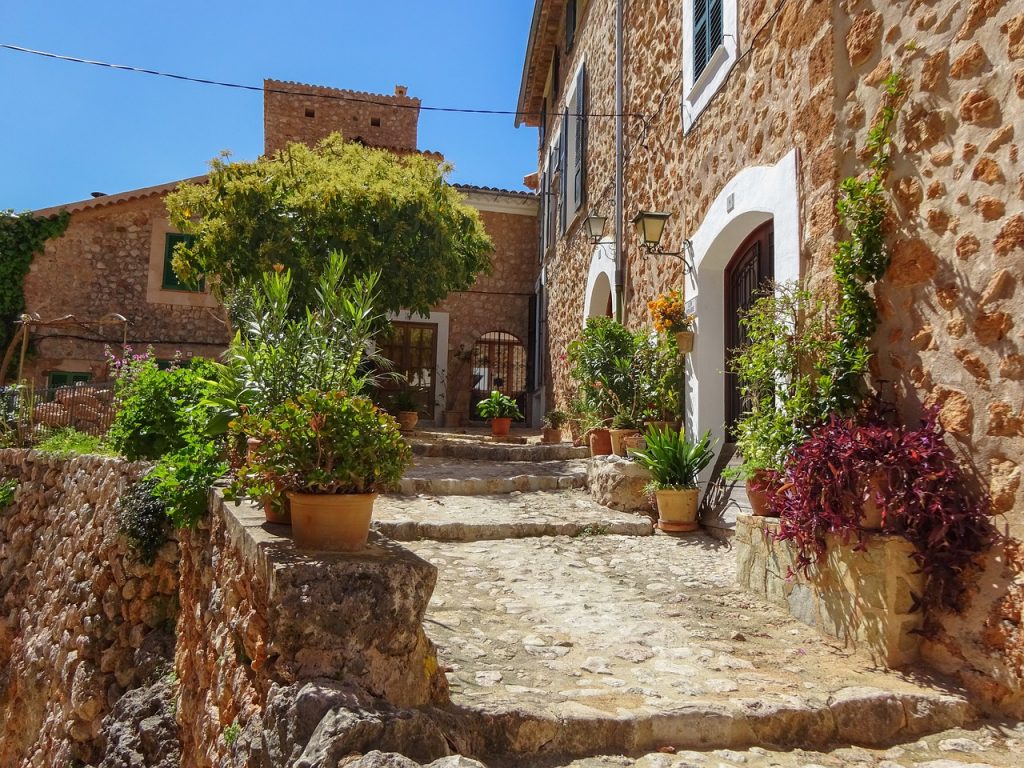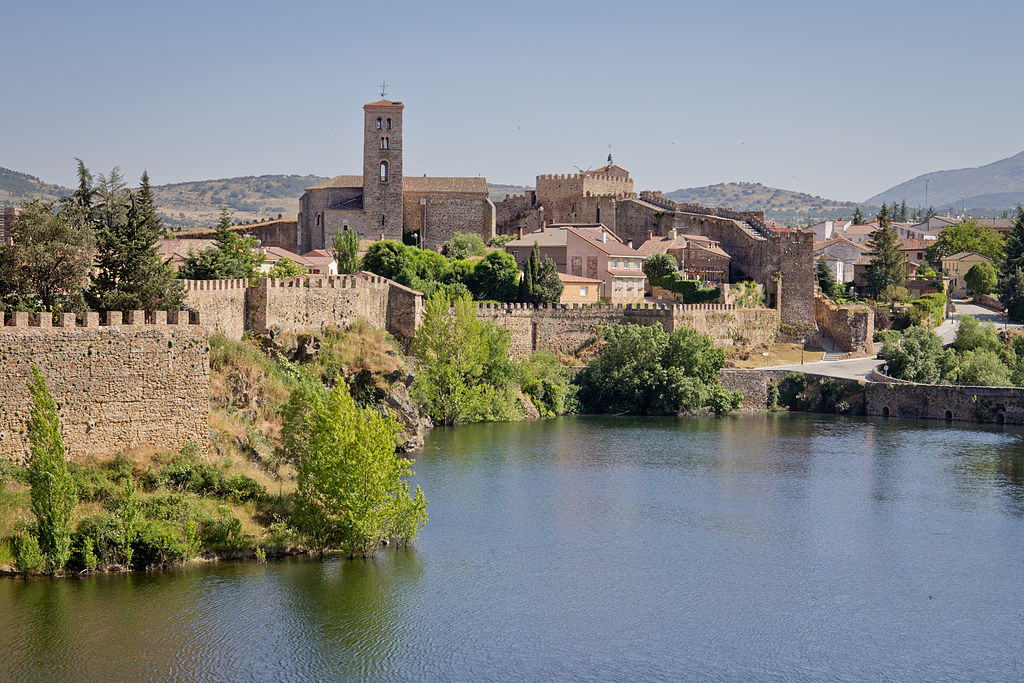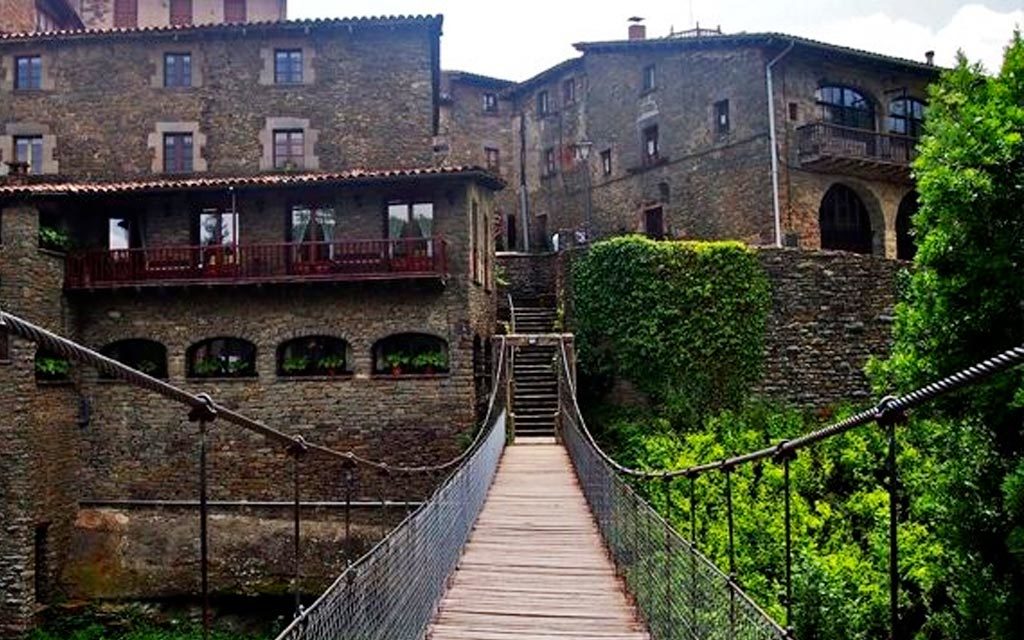Spain has thousands of small villages. One is always more idyllic, more charming, or tinier than the other. Because visiting all those pittoresque villages is not realistic, we’ve lined up 10 Spanish villages for you. We’ve selected some special ‘pueblos’ – most of the time ‘blancos’ too – with a long history and interesting things to see and do.
If you’re looking for somewhere a little different to the big cities, then give some of these 10 Spanish villages a try.
Fornalutx- Mallorca

This magical village is on the island of Mallorca. In the Tramontana Mountains, it has beautiful views over the coastal town of Sóller. It covers an area of 19 km2 and had a total of 687 inhabitants in 2018. Due to its location in the mountains, the village has many height differences, so that most streets are sloping or even consist entirely of stairs.
Related post: Port de Valldemossa, beautiful coastal village in Mallorca
The village is of great artistic and architectural value. This is reflected in the medieval buildings, such as the 13th-century Gothic church of Fornalutx, and the typical houses of Mallorca, with yellow-orange stones and red roof tiles. The 17th-century Casa de la Villa is also worth a visit.
Aveinte- Ávila
The town of Aveinte is in the province of Ávila, in the region of Castile and León. Just over 20 kilometres northwest of the city of Ávila, on the road that runs to Salamanca is this tiny village. The name is said to refer to the distance the village is from the city of Ávila (‘a veinte kilómetros’). It has an area of less than 13 km2 and had 86 inhabitants in 2018. This makes Aveinte the smallest village on this list. Due to its extremely modest size and the tranquility that comes with it, this medieval village is very suitable for relaxing and enjoying the surrounding nature.
Buitrago de Lozoya – Madrid

Perhaps the prettiest village in the Madrid region is the medieval town of Buitrago de Lozoya. It is about 80 kilometres north of the Spanish capital, at the foot of the Guadarrama Mountains. It gets its name from the river that surrounds the village, the Lozoya. The village has been completely walled with an 800 meter long wall since the 11th century; and the Marquis of Santillana even had a hospital built there. It is one of the few places with an almost intact historic centre, which incidentally consists of many Arab buildings such as the castle (Alcázar), Casa del Bosque or the church of Santa María del Castillo. Don’t forget to visit the Picasso museum. In 2017, the village had 1,854 inhabitants, spread over an area of 27 km2.
Chinchón- Madrid

The origins of this village in the Madrid region go back to the time of the Neolithic, i.e. somewhere between 12,000 and 5,000 BC. In 1974, Chinchón was declared a ‘Conjunto Histórico-Artístico’ (National Heritage of Buildings), which means that today many tourists visit the town. It has a beautiful ‘Plaza Mayor’ where you can now enjoy a delicious meal in one of the restaurants located in the galleries where the bullfight spectators used to sit.
The living nativity scene and the Semana Santa attract many extra visitors. In addition, the village has several caves where you can enjoy a nice Spanish wine. Chinchón is located about 50 kilometres southeast of Madrid and has an area of 116 km2. In 2018, the village had 5,239 inhabitants.
Santillana del Mar – Cantabrië
Although the name suggests otherwise, this village is not directly on the sea. It is about 7 kilometres inland on the Bay of Biscay, about 30 kilometres west of Santander. (Cantabria) The village has an area of 29 km2 and had 4,172 inhabitants in 2018.
The cave of Altamira, known for its rock paintings that were included in the UNESCO World Heritage List in 1985, is right next to the village. It is possible that Santillana del Mar dates from the same time as these petroglyphs, the Paleolithic era (between 35,000 and 11,000 BC). During a trip through the Cantabria region, a stop in this village should not be missed. Don’t miss the 12th-century Romanesque collegiate church of Santa Juliana and the towers of Merino and don Borja, one of the oldest structures.
Ronda
From all Spanish villages in this list, this might be one of the most famous. In the province of Málaga, above a 750 meters deep ravine, about 60 kilometres northwest of Marbella, is the special village of Ronda. The historic city centre dates from the time of the Arabs, but the most special building is the stone bridge that runs over the ravine. Another building worth visiting is the arena from the 18th century. From the ‘mirador’ you can enjoy an unprecedented view of the area.
In the nearby cave of la Pileta, remains of paintings from the Paleolithic era and possibly even from the Neolithic era have been found. With its 33,877 inhabitants in 2019 over an area of 398 km2, Ronda is the largest village on this list. Furthermore, if you have time to spare, consider consider a visit to Setenil de las Bodegas. This village is located on the “Ruta de los Pueblos Blancos” in the Sierra de Cádiz. Here, houses are buried in the sandstone cliffs that form the village. These are not cave houses like in Gaudix, but “abrigo rocas”, which literally translates as “rock shelter”
Rupit i Pruit – Barcelona

Near Barcelona, about 100 kilometres north of the city and about 65 kilometres west of Girona, is the beautiful village of Rupit at almost 900 meters altitude, with the adjacent village of Pruit. When you arrive in Rupit, it seems as if you have taken a step back in time. One of the entrances to the village is via a suspension bridge over a river. What is striking is the view over the idyllic stone houses. They seem to come straight out of a fairytale. Even the pavers are perfectly and completely hand laid. The population of these two villages together has been declining for years. In 2019, the counter stood at only 279 inhabitants. These are spread over an area of 48 km2.
Frias- Burgos

In the province of Burgos, the village of Frías is about 80 kilometres northeast of the provincial capital. Until 1202, this example of sightly Spanish villages belonged to the kingdom of Navarre, after that it became part of the kingdom of Castile and León. The special thing about Frías is the medieval atmosphere that still hangs in the village because of the castle, which is pontifically present.
The medieval village centre has therefore been declared a ‘Conjunto Histórico-Artístico’ (National Heritage of Buildings). On the edge of the village, the houses seem to hang above a cliff. Frías is about 30 km2 in size and had 252 inhabitants in 2019.
Sigüenza- Guadalajara
In the province of Guadalajara, about 70 kilometres northeast of the provincial capital, is the medieval town of Sigüenza. It is also known as ‘la Ciudad del Doncel’ (the City of the Young Nobleman). The town owes this nickname to the tomb of a young nobleman, which is considered one of the masterpieces of funerary art. In 1965 Sigüenza was proclaimed ‘Conjunto Histórico-Artístico’. The castle, the cathedral and the main square are, next to the tomb, the three biggest attractions; however, the whole town is full of history.
The streets date back to the Middle Ages and even a number of buildings from that time are still standing. Sigüenza is then officially not a village, but it should not be missing from this list. Sigüenza has an area of 387 km2 and 4,309 inhabitants in 2019. Therefore, you won’t notice you are walking around a city instead of a village.
Penafiel- Valladolid
Some of todays still stunning Spanish villages have an origin which is estimated in prehistoric times. Like Peñafiel, located about 56 kilometres east of Valladolid. After the conquest of the village from the Arabs in the 11th century, the Christians built no less than 18 churches and three monasteries. Today you can still find the striking castle, the tower Torre del Reloj, the Coso square and 4 churches. Due to its location at 754 meters altitude, you have a beautiful view of the area. The village has an area of 76 km2 and was home to 5,037 inhabitants in 2019.
For more inspiration, check out our Travel in Spain section.


